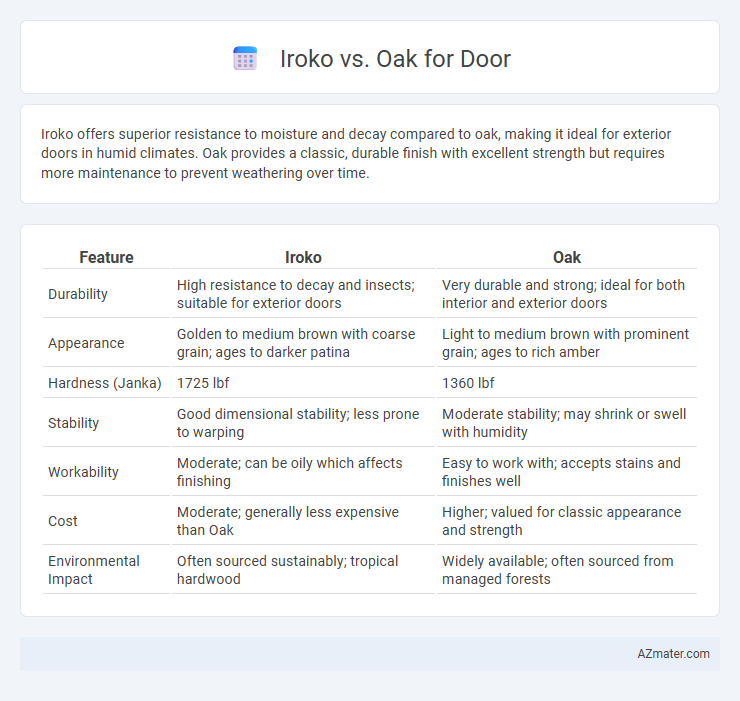Iroko offers superior resistance to moisture and decay compared to oak, making it ideal for exterior doors in humid climates. Oak provides a classic, durable finish with excellent strength but requires more maintenance to prevent weathering over time.
Table of Comparison
| Feature | Iroko | Oak |
|---|---|---|
| Durability | High resistance to decay and insects; suitable for exterior doors | Very durable and strong; ideal for both interior and exterior doors |
| Appearance | Golden to medium brown with coarse grain; ages to darker patina | Light to medium brown with prominent grain; ages to rich amber |
| Hardness (Janka) | 1725 lbf | 1360 lbf |
| Stability | Good dimensional stability; less prone to warping | Moderate stability; may shrink or swell with humidity |
| Workability | Moderate; can be oily which affects finishing | Easy to work with; accepts stains and finishes well |
| Cost | Moderate; generally less expensive than Oak | Higher; valued for classic appearance and strength |
| Environmental Impact | Often sourced sustainably; tropical hardwood | Widely available; often sourced from managed forests |
Introduction to Iroko and Oak Wood
Iroko wood, often called African Teak, is a durable hardwood known for its rich golden to medium brown color and high resistance to decay and insects, making it ideal for exterior doors. Oak wood, widely recognized for its strength and distinctive grain patterns, offers exceptional hardness and long-lasting durability, typically available in red and white varieties suited for both interior and exterior doors. Both woods provide excellent structural integrity, but Iroko's natural oil content offers superior weather resistance compared to oak.
Origin and Availability of Iroko vs Oak
Iroko wood originates primarily from the west coast of Africa, including countries like Ghana, Nigeria, and the Congo Basin, where it thrives in tropical forests. Oak is native to the temperate regions of the Northern Hemisphere, especially widespread in Europe and North America, with species such as English oak and white oak being most common. Availability of iroko can be limited outside Africa due to export regulations and sustainable harvesting concerns, whereas oak is abundantly available globally in lumber markets, benefiting from well-established forestry and supply chains.
Appearance and Aesthetic Differences
Iroko wood features a warm golden to medium brown hue with dark streaks, creating a rich, tropical appearance that darkens over time, enhancing its exotic aesthetic. Oak offers a lighter, more uniform coloration ranging from light beige to medium brown, often showcasing prominent grain patterns and knots that contribute to a classic, rustic charm. The distinct grain texture of oak provides a more traditional look, while iroko delivers a smoother, more contemporary finish suitable for modern door designs.
Durability and Strength Comparison
Iroko wood offers exceptional durability with natural oil content that resists rot, insects, and moisture, making it ideal for exterior doors exposed to harsh weather. Oak, known for its dense hardwood structure, provides superior strength and impact resistance but requires treatment to prevent decay over time outdoors. In terms of longevity, Iroko generally outperforms oak in wet environments, while oak excels in structural stability and aesthetic grain for interior or protected door applications.
Resistance to Weather and Decay
Iroko wood offers superior resistance to weather and decay compared to Oak, making it a preferred choice for exterior doors exposed to harsh climates. Its natural oils and dense grain provide excellent protection against moisture, fungi, and insect damage, extending the door's lifespan significantly. Oak, while durable, requires regular treatment and maintenance to withstand prolonged exposure to outdoor elements without degrading.
Maintenance Requirements for Iroko and Oak Doors
Iroko doors require minimal maintenance due to their high natural oil content, which makes them resistant to rot and insects, thus needing only occasional cleaning and oiling to preserve their appearance. Oak doors demand more frequent upkeep, including regular sealing or varnishing to protect against moisture and prevent warping or cracking over time. Both hardwoods are durable, but Iroko's lower maintenance makes it ideal for external door applications where weather resistance is crucial.
Environmental Impact and Sustainability
Iroko wood, sourced primarily from West Africa, is known for its durability but often raises concerns due to deforestation and less stringent logging regulations, impacting biodiversity. Oak, particularly from sustainably managed European forests, benefits from certification programs like FSC, promoting responsible harvesting and forest regeneration. The carbon footprint of oak is generally lower than Iroko, making oak a more environmentally sustainable choice for eco-conscious door manufacturing.
Cost Comparison: Iroko vs Oak
Iroko doors generally offer a more cost-effective option compared to oak, with prices typically 20-30% lower due to Iroko's faster growth and abundant availability. Oak is priced higher because of its premium status, durability, and slower growth rate, which increases supply-chain costs. Choosing Iroko can reduce upfront expenses while still providing a hardwood door that resists wear and weather effectively.
Best Applications for Each Wood Type
Iroko's high durability and natural resistance to moisture make it ideal for exterior doors exposed to harsh weather conditions, while its rich golden hue adds a distinctive aesthetic to modern designs. Oak, known for its strength and classic grain pattern, excels in interior doors, offering excellent stability and the ability to take stains and finishes uniformly for a refined look. Both woods provide long-lasting performance, but choosing Iroko for outdoor use and Oak for indoor settings maximizes their inherent properties.
Conclusion: Which Wood is Better for Doors?
Iroko and oak are both durable hardwoods suitable for doors, but Iroko offers superior natural resistance to rot and insects, making it ideal for exterior doors in humid or wet climates. Oak, especially white oak, provides exceptional strength and a classic aesthetic favored for interior doors and traditional designs. Choosing between Iroko and oak ultimately depends on environmental conditions and desired appearance, but for outdoor durability, Iroko has the edge over oak.

Infographic: Iroko vs Oak for Door
 azmater.com
azmater.com